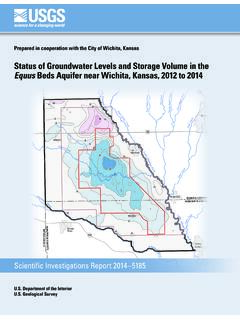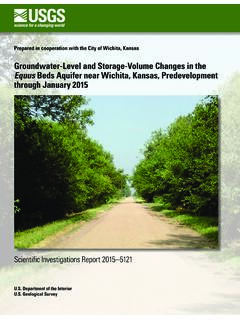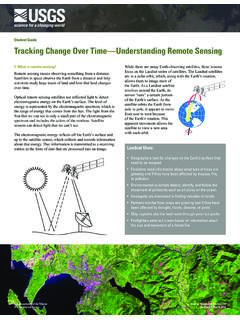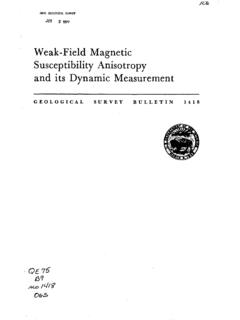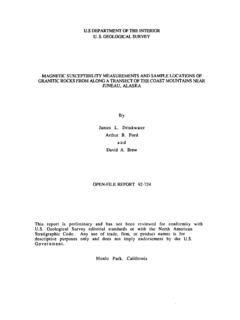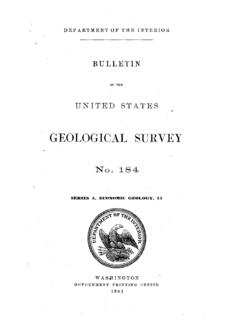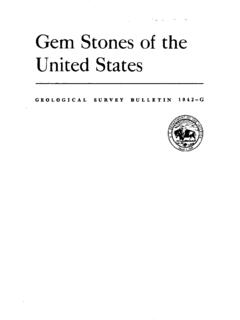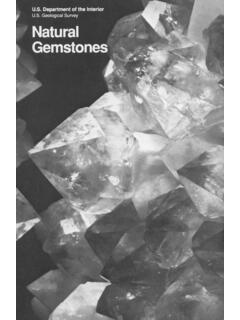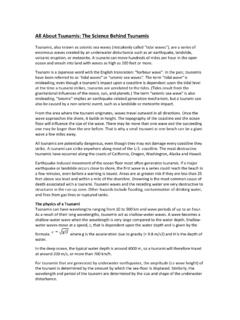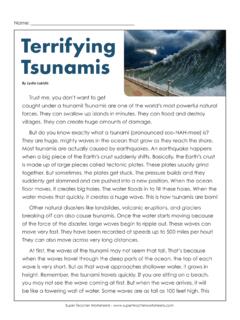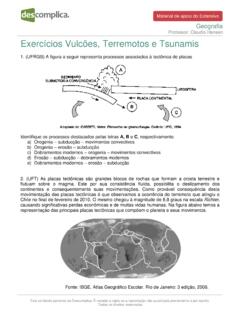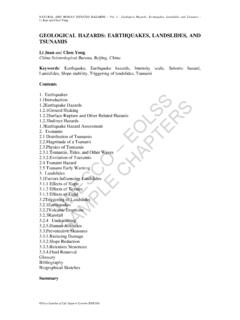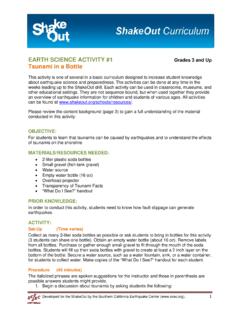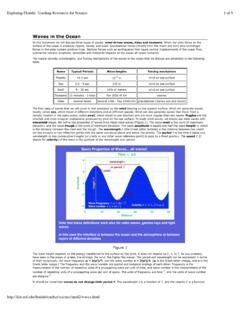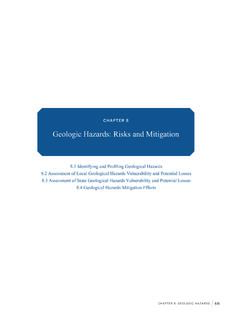Transcription of The 1964 Great Alaska Earthquake and Tsunamis—A …
1 Department of the Geological SurveyFact Sheet 2014 3018 March 2014 IntroductionThe magnitude Great Alaska Earthquake , which struck south-central Alaska at 5:36 on Friday, March 27, 1964, is the largest recorded Earthquake in history and the second-largest Earthquake recorded with modern instruments. The Earthquake was felt throughout most of mainland Alaska , as far west as Dutch Harbor in the Aleutian Islands 800 miles away from Anchorage, and at Seattle, Washington, more than 1,200 miles to the southeast of the fault rupture, where the Space Needle swayed perceptibly. The Earthquake caused rivers, lakes, and other waterways to slosh as far away as the coasts of Texas and Louisiana.
2 Water-level recorders in 47 states the entire The 1964 Great Alaska Earthquake and Tsunamis A Modern Perspective and Enduring LegaciesNation except for Connecticut, Delaware, and Rhode Island registered the Earthquake . It was so large that it caused the entire Earth to ring like a bell: vibrations that were among the first of their kind ever recorded by modern instruments. The Great Alaska Earthquake spawned thousands of lesser aftershocks and hundreds of damaging landslides, submarine slumps, and other ground failures. Alaska s largest city, Anchorage, located west of the fault rupture, sustained heavy property damage. Tsunamis produced by the Earthquake resulted in deaths and damage as far away as Oregon and California.
3 Altogether the Earthquake and subsequent tsunamis caused 129 fatalities and an estimated $ billion in property losses (in 2013 dollars). Most of the population of Alaska and its major transportation routes, ports, and infrastructure lie near the eastern segment of the Aleutian Trench that ruptured in the 1964 Earthquake . Although the Great Alaska Earthquake was tragic because of the loss of life and property, it provided a wealth of data about subduction-zone earthquakes and the hazards they pose. The leap in scientific understanding that followed the 1964 Earthquake has led to major breakthroughs in earth science research worldwide over the past half century. This fact sheet commemorates the Great Alaska Earthquake and examines the advances in knowledge and technology that have helped to improve Earthquake preparation and response both in Alaska and around the world.
4 Damage to the Seward Highway caused by the 1964 Great Alaska Earthquake . Photograph by the RiverDeltaPACIFIC OCEANNORTH AMERICANPLATEPACIFIC PLATEM odern seismic stationsVolcanoesMovement of plateMILES0100U P L I F T A N DS U B S U R F A C ER U P T U R ES U B S I D E N C EAleutian TrenchMontagueIslandD e n a l i F a u l tTurnagainHeightsGovernment HillAnchorage010 MILESNNCANADA(detailed map)ALASKAT urnagain ArmScientific Impact of the Great Alaska EarthquakeSupport for the Theory of Plate TectonicsAt first, geologists did not know how such a huge Earthquake could have happened, because the prevailing theories of the day could not explain such a large movement. So they examined the Earthquake within the framework of a new theory, plate tectonics, which proposed that the crust of the Earth consists of about a dozen or so major sections, or plates, that sit on top of the hot mantle below and slowly move past each other or collide.
5 Compelling evidence for this theory is that most earthquakes occur near the boundaries of these plates, and the plates movements through geologic time help to explain many of the landforms and processes that we observe on scientists now recognize that the 1964 Great Alaska Earthquake resulted from plate convergence: where the Pacific Plate is being overridden by the North American Plate, it descends, or subducts, into the Earth s mantle along the Aleutian Trench. Subduction zones like southern Alaska s occur throughout the world, and the 1964 Alaska Earthquake was the first to be generally understood by earth scientists as having occurred on a subduction zone interface: the slip was along the gently dipping boundary, or megathrust fault, between the denser downgoing oceanic plate and the lighter overriding continental plate.
6 Since 1964, subduction zones have been recognized elsewhere, including Indonesia, Japan, and Chile, where Great earthquakes have also occurred during the past 60 years. The understanding gained from the 1964 Great Alaska Earthquake provided the geological framework for assessing the Earthquake and tsunami hazards at all convergent margins around the world. For example, the tsunamis produced by the 1964 Great Alaska Earthquake was one of the first events to demonstrate to scientists that an Earthquake may cause changes of seafloor depth that generate transoceanic tsunamis. The 1964 Earthquake was giant because of the large area of the fault that slipped during the Earthquake and the large amount of slip, or relative motion, between opposite sides of the Earthquake fault.
7 Current estimates of the average slip along the megathrust fault during the 1964 Earthquake are in the range of 30 feet, with some patches that slipped as much as 60 feet! Map of southern Alaska showing the epicenter of the 1964 Great Alaska Earthquake (red star), caused when the Pacific Plate lurched northward underneath the North American Plate. There was extensive damage to coastal towns and infrastructure throughout the region, particularly in Anchorage, Seward, Whittier, and Valdez. Widespread uplift occurred seaward of Kodiak Island and the Kenai Peninsula, while subsidence occurred inland as a result of the magnitude Earthquake . In 1964, there were no instruments in Alaska capable of recording the Earthquake , but now there is an extensive network of stations (yellow squares) that monitor the seismically active plate boundary along the Aleutian damage to the waterfront area of Kodiak, Alaska .
8 USGS photograph by George and Explanation of Earthquake Ground DeformationGeologists from the Geological Survey (USGS) were the first earth scientists to respond to the devastated region, and they mapped land-level changes resulting from the 1964 Earthquake all along the coast of southern Alaska . They were astonished to find that the Earthquake was accompanied by vertical shifts of the Earth s surface over an area two-thirds the size of California. Parts of the coast sank, or subsided, as much as 8 feet, and other parts rose by as much as 38 feet. In addition, geodetic surveys showed that much of coastal Alaska moved seaward at least 50 feet. The uplift and subsidence data from the 1964 Earthquake have been repeatedly used to test models of how subduction zones rupture during Great earthquakes and to calculate how much the plates shifted along the fault plane at depth.
9 It is now recognized that major subduction-zone earthquakes produce a pattern of uplift of the coastline above the shallowest and most seaward part of a rupture, and that subsidence of the coastline occurs farther inland from the rupture. This pattern gradually reverses over a period of decades to centuries as continuing plate motion restores the Earth s surface to its pre- Earthquake state. This cyclic pattern was first revealed in the studies following the 1964 Earthquake . In areas experiencing initial sudden subsidence, such as Cook Inlet and much of Kodiak Island, coastal forests and peaty marsh deposits dropped below sea level and were killed by the sudden inundation by salt water.
10 These drowned forests become buried by marine silt, and, in some places, by tsunami sand deposits. During the gradual uplift that follows, salt-water-tolerant peat eventually accumulates on the marine silt, and new forests grow on the peat. In other places, such as the Copper River Delta, located closer to the Aleutian Trench, sudden uplift occurs first, followed by slow submergence between cores collected through these cyclic uplift/subsidence deposits have yielded an unprecedented 5,600-year-long record of Great earthquakes along the southern Alaska coast. In the Copper River Delta, the cores show evidence of 9 prehistoric earthquakes, implying an average interval of about 600 years between 1964-type Great earthquakes in southern Alaska .
